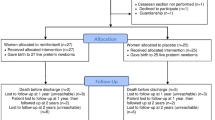Abstract
Purpose
Maternal remifentanil infusion is used for minimally invasive fetal surgery or ex-utero intrapartum treatment. The fetal-to-maternal (F/M) ratio of remifentanil concentration at various dosing regimens is useful to manage remifentanil effects. The aim of this study was to investigate the F/M ratio of remifentanil at various concentrations.
Methods
Five pregnant ewes received continuous remifentanil infusion under propofol anesthesia. The remifentanil infusion rate was increased by 0.4 µg/kg/min every 15 min. The response to tail clamping in fetuses was assessed immediately before the change of infusion rate. Arterial remifentanil concentrations in the mother and fetus were determined at each tail clamp. After observing a loss of response to tail clamping, remifentanil infusion was terminated and the concentrations were assessed.
Results
The median remifentanil maximum infusion rate and maternal concentration were 3.0 µg/kg/min (range 2.4–3.6) and 21.6 (range 18.0–29.9) ng/mL, respectively. During continuous infusion, the F/M ratio was 0.15 (0.07–0.17), and the slope of the linear regression for the F/M ratio versus infusion rate in each individual was −0.001 ± 0.012/μg kg min (P = 0.876 vs hypothetical value of 0). The F/M ratio at the first sampling point in the elimination phase [0.33 (0.07–0.65)] was higher (P = 0.033) than at the last sampling point during continuous infusion [0.15 (0.06–0.17)].
Conclusion
The F/M ratio was constant at a steady state regardless of the remifentanil concentration up to 29.9 ng/mL, and increased in the elimination phase in pregnant ewes.



Similar content being viewed by others
References
Harrison MR, Anderson J, Rosen MA, Ross NA, Hendrickx AG. Fetal surgery in the primate I. Anesthetic, surgical, and tocolytic management to maximize fetal-neonatal survival. J Pediatr Surg. 1982;17:115–22.
Mychaliska GB, Bealer JF, Graf JL, Rosen MA, Adzick NS, Harrison MR. Operating on placental support: the ex utero intrapartum treatment procedure. J Pediatr Surg. 1997;32:227–30.
Chalouhi GE, Essaoui M, Stirnemann J, Quibel T, Deloison B, Salomon L, Ville Y. Laser therapy for twin-to-twin transfusion syndrome (TTTS). Prenatal Diagn. 2011;31:637–46.
Adzick NS, Thom EA, Spong CY, Brock JW 3rd, Burrows PK, Johnson MP, Howell LJ, Farrell JA, Dabrowiak ME, Sutton LN, Gupta N, Tulipan NB, D’Alton ME, Farmer DL, Moms Investigators. A randomized trial of prenatal versus postnatal repair of myelomeningocele. N Engl J Med. 2011;364:993–1004.
Anand KJ, Hickey PR. Pain and its effects in the human neonate and fetus. N Engl J Med. 1987;317:1321–9.
Anand KJ, Sippell WG, Aynsley-Green A. Randomised trial of fentanyl anaesthesia in preterm babies undergoing surgery: effects on the stress response. Lancet. 1987;1:62–6.
Fisk NM, Gitau R, Teixeira JM, Giannakoulopoulos X, Cameron AD, Glover VA. Effect of direct fetal opioid analgesia on fetal hormonal and hemodynamic stress response to intrauterine needling. Anesthesiology. 2001;95:828–35.
Van de Velde M, Van Schoubroeck D, Lewi LE, Marcus MA, Jani JC, Missant C, Teunkens A, Deprest JA. Remifentanil for fetal immobilization and maternal sedation during fetoscopic surgery: a randomized, double-blind comparison with diazepam. Anesth Analg. 2005;101:251–8.
Fink RJ, Allen TK, Habib AS. Remifentanil for fetal immobilization and analgesia during the ex utero intrapartum treatment procedure under combined spinal-epidural anaesthesia. Br J Anaesth. 2011;106:851–5.
Coonen JB, Marcus MA, Joosten EA, van Kleef M, Neef C, van Aken H, Gogarten W. Transplacental transfer of remifentanil in the pregnant ewe. Br J Pharmacol. 2010;161:1472–6.
Ouattara A, Boccara G, Kockler U, Lecomte P, Leprince P, Leger P, Riou B, Rama A, Coriat P. Remifentanil induces systemic arterial vasodilation in humans with a total artificial heart. Anesthesiology. 2004;100:602–7.
Kaye AD, Baluch A, Phelps J, Baber SR, Ibrahim IN, Hoover JM, Zhang C, Fields A. An analysis of remifentanil in the pulmonary vascular bed of the cat. Anesth Analg. 2006;102:118–23.
Laster MJ, Liu J, Eger EI 2nd, Taheri S. Electrical stimulation as a substitute for the tail clamp in the determination of minimum alveolar concentration. Anesth Analg. 1993;76:1310–2.
Masui K, Kira M, Kazama T, Hagihira S, Mortier EP, Struys MM. Early phase pharmacokinetics but not pharmacodynamics are influenced by propofol infusion rate. Anesthesiology. 2009;111:805–17.
Ansari J, Carvalho B, Shafer SL, Flood P. Pharmacokinetics and pharmacodynamics of drugs commonly used in pregnancy and parturition. Anesth Analg. 2016;122:786–804.
Kan RE, Hughes SC, Rosen MA, Kessin C, Preston PG, Lobo EP. Intravenous remifentanil: placental transfer, maternal and neonatal effects. Anesthesiology. 1998;88:1467–74.
Ngan Kee WD, Khaw KS, Ma KC, Wong AS, Lee BB, Ng FF. Maternal and neonatal effects of remifentanil at induction of general anesthesia for cesarean delivery: a randomized, double-blind, controlled trial. Anesthesiology. 2006;104:14–20.
Egan TD, Lemmens HJ, Fiset P, Hermann DJ, Muir KT, Stanski DR, Shafer SL. The pharmacokinetics of the new short-acting opioid remifentanil (GI87084B) in healthy adult male volunteers. Anesthesiology. 1993;79:881–92.
Acknowledgements
The authors would like to thank Dr. Eiichi Inada, Department of Anesthesiology and Pain Medicine, Juntendo University, for his advice on conducting this study, and Dr. Futoshi Kimura, Tomoyuki Kudo, Tsuyoshi Kudo, and Mihoko Kudo, Department of Anesthesiology, Hirosaki University, for their advice on sample acquisition and handling.
Author information
Authors and Affiliations
Corresponding author
Ethics declarations
Funding
This study was supported by the Grant from the National Center for Child Health and Development 24-2, Japan.
Conflict of interest
The authors declare no conflict of interests.
About this article
Cite this article
Sato, M., Masui, K., Sarentonglaga, B. et al. Influence of maternal remifentanil concentration on fetal-to-maternal ratio in pregnant ewes . J Anesth 31, 517–522 (2017). https://doi.org/10.1007/s00540-017-2332-4
Received:
Accepted:
Published:
Issue Date:
DOI: https://doi.org/10.1007/s00540-017-2332-4




